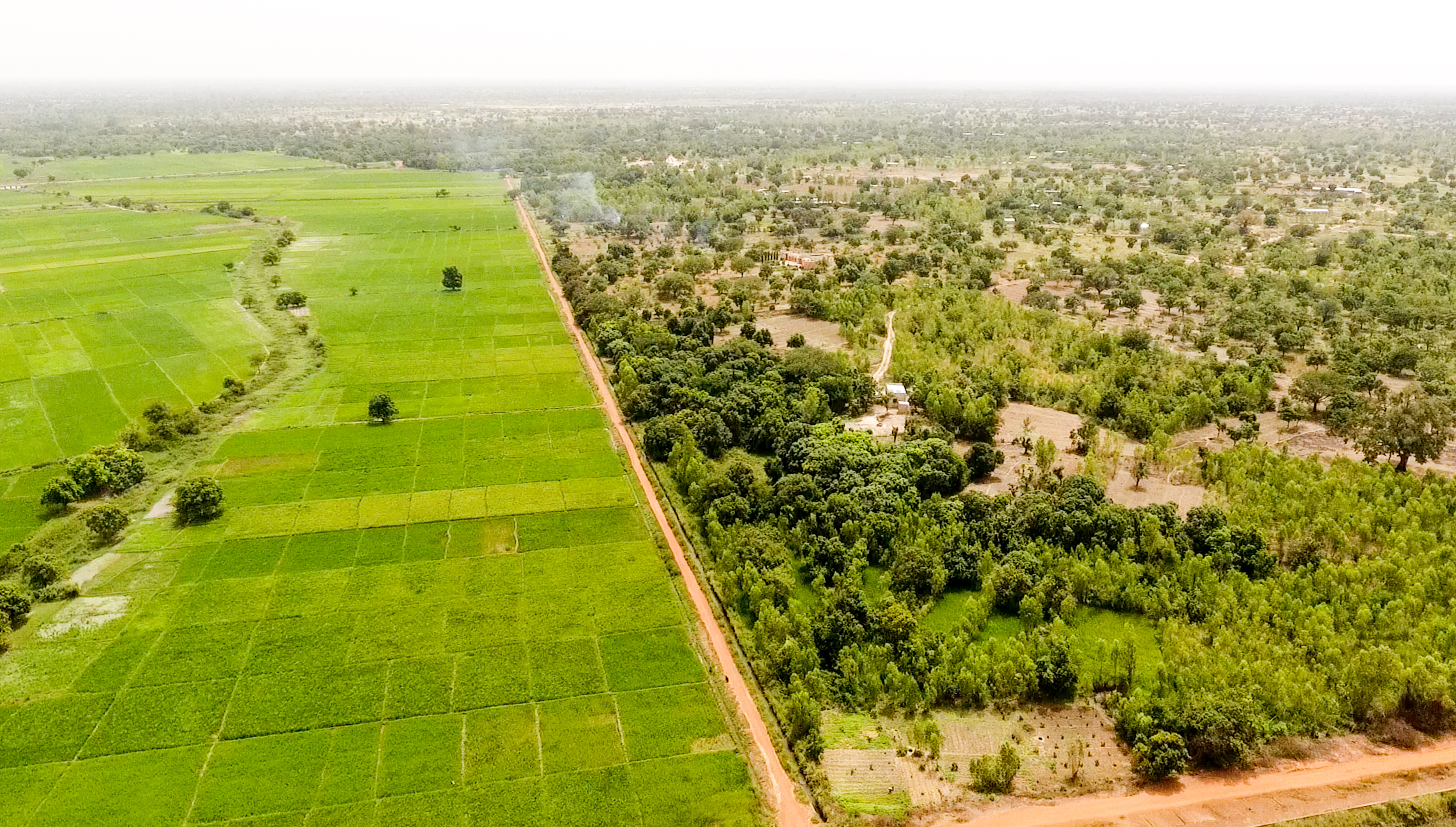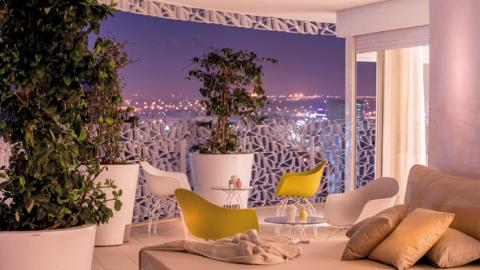When we think of Casablanca, the Hassan II mosque comes to mind, or even the Twin Centre or Liberty building. From now on, a new building will take its place among the classic sites of the economic capital of Morocco and breathe new life into the city. Inaugurated on 27th March 2018, the first plant-covered tower block in Africa and the Middle East, promoted by Yasmine Immobilier, is a veritable architectural and botanical masterpiece.

Designed by one of Europe’s most progressive architects, the Edouard François studio, the plant-covered towers of Casablanca have been designed as a neighbourhood in itself where you can live, work, go shopping and simply go for a stroll without needing to get into your car. Once the project is completed, it will have a total of four towers (three residential tower blocks and one office block), and 11 surrounding low-rise residential buildings, all completely open to nature and surrounded by green spaces. The constructed area only, in fact, represents 30% of the total project area, with 70% being allocated to green spaces, a central square, promenades, swimming pools and other recreational areas.
Therefore, the clients will be able to choose between apartments located in 16-storey plant-covered towers or apartments located in an eight-storey support building. The green towers, adorned with white bougainvillea, honeysuckle and jasmines, have a spacious balcony on each floor, which is ideal for appreciating the panoramic view of the Casablanca skyline. These towers will have a range of 384 apartments and duplex dwellings, as well as 6 penthouses with an area ranging from 50 to 300 m2. As for the eight-storey low-rise blocks, they will have the benefit of private gardens and landscaped terraces. Each level will have a maximum of 3 residents.
The project will have three phases; the first phase having been delivered during 2018. This first tranche comprised a first tower of 16 storeys (56 metres in height) and four low-rise buildings of four storeys. This is the first plant-covered tower to be built in Africa and the Middle East, which gives priority to the green spaces. Edouard François, the project architect, stated that the underlying concept was: “to have a building that resembles a Fabergé egg. Apart from the shape, we wanted the building to be organic and also pay great attention to detail. We, therefore, covered the structure with a high-value resin, honeycomb shaped. The idea was for all the vegetation to be planted gradually”.
Situated on the historic site of the old Anfa airport “the project required the expertise of international landscape architects and water engineers and quite a few gardeners”.
Each tranche has almost 150 apartments, 10 retail premises and 16 offices, the whole structure being built on a plot measuring 50,000 m2.
General information about the Irrigation Project
The project is divided up into 3 lots (Lot 122, Lot 123 and lot 124). The studies relating to irrigation were carried out between 2013 and 2015 for the tower works and the technical areas. Consultations with the contractors were subsequently conducted for the first Lot: lot 122. Work began on the first lot (Lot 122) in early-2016. Work began on the second lot (Lot 123) in early 2018.
Lot 122 comprises one 16-storey tower and one rooftop area, as well as the surrounding 4 outbuildings. Lot 123 consists of one 16-storey tower and a rooftop area as well as a
7-storey office block and one rooftop area and the surrounding two outbuildings. Lot 124 consists of one 16-storey tower and one rooftop area as well as 5 surrounding outbuildings. Only Lot 122 is completed. It was inaugurated in March 2018. The delivery of Lot 123 is planned for 2019 and that of Lot 124 in 2021.
Due to the way the work is divided up and separated by the roads and the tramway, each lot is managed separately with its own individual water supply. Furthermore, for automatic irrigation, there are 3 sources of water supply for the whole project.
In each pf the towers, there are 70 cm and 80 cm pots positioned on the terraces as well as 8 to 22 flower boxes per floor and on the 17th floor, there is a terrace roof adorned with a very large 1 m tub, which looks over the whole periphery of the tower. These flower boxes are planted with white Bougainvillea, honeysuckle and jasmine. During the research phase, hydraulic calculations were carried out by JFL Concept so as to ensure that the applications of water are regular and adapted to the volume of the substrates present for each pot, level of exposure, type of plants.
As far as the surrounding buildings are concerned, they have flower beds and shrubs and also palm trees.
During the studies, the amount of water required was calculated to determine the capacity of the daily water supply to provide irrigation for the tubs on the towers and flower pots on the roofs, on the one hand, and on the forecourt and ground area, on the other. The storage tanks have an available capacity of 40 m3. They are installed in the basement of the residential blocks. There is one storage tank in each tower for drinking water and one for irrigation water.
Two pumping stations are installed in a specific irrigation control room in each tower, one for irrigating the flower beds and roof gardens of the tower and one for irrigating the surrounding green spaces, on the ground floor. The surrounding buildings have flowers beds and shrubs, and also palm trees. Thus, for each lot, there are two separate irrigation systems. The pumping stations have different technical characteristics because of the flow rates and dynamic pressures required, which vary according to the needs of the ground floor area and the towers, For the tower, the pumping station consists of 2 variable speed pumps with an individual flow rate of 3 m3/h and a pressure of 11-11.5 bar. The pumping station for surroundings consists of 2 variable speed pumps with an individual flow rate of 8 m3/h and a pressure of 6.5 to 7 bar. Each station is equipped with 2 pumps so that they can be alternated and also so as to have the relevant flow and pressure available in each pump for maintenance.
The hydraulic equipment is located in the service room in the basement: i.e. one self-cleaning 100µ screen filter. There are two pressure ranges for the filter stations: 10 and 16 bar. For the tower system, the filter (16 bar) will be connected to a master valve, normally open, which functions during the back-wash because of the flow rates required. A pressure vessel or bladder allows the appropriate flow rate to be applied for the backwash.
Irrigation systems of the surroundings
As far as the installation of the irrigation system for surroundings is concerned, the primary system covers the green spaces. It is made of high-density polyethylene (HDPE). There are PVC pipes in the service room. ICV Hunter 1” and 1½” solenoid valves are installed in the valve boxes and adjustable pressure regulators are installed on each solenoid valve. Each solenoid valve is equipped with a decoder for connecting to the specific irrigation controller at ground level. The secondary system is made of HDPE and covers the green spaces. Only a drip irrigation system is used with in-built self-regulating drippers.
Three bubblers with a flow rate of 60 l/h irrigate the palm trees planted at ground level. They are connected to the tower’s primary system. The 1” solenoid valve is housed in the service room and allows for the water requirements to be adjusted according to the specific types of vegetation.
Irrigation systems of the towers
As far as the towers and the forecourts are concerned, the primary system leads through the basement and service shafts or ducts of the tower. The PVC pipes and ducts have a pressure of 16 bar. The solenoid valves installed in the specific irrigation control cabinet, are located in the service ducts and control room. Each ICV 1” Hunter solenoid valve is fitted to an adjustable pressure regulator. A decoder is also fitted to each solenoid valve allowing it to be connected to a specific controller in the tower via a 2 x 2.5 mm2 cable.
Two controllers are located in the service room. One decoder-based ACC controller is located in each primary system allowing the irrigation of the green spaces at ground level to function separately from the irrigation of the tubs and pots on the rooftops of the towers.
Flow sensors are installed for each installer so as to have return flow and thus ensure optimum maintenance. ACC decoder-based controllers are also equipped with a remote control so as to carry out the maintenance directly on site and monitor the status of the solenoid valves. Thus, there are two controllers per lot, i.e. 6 in total.
An in-depth look at the irrigation of the flower pots of the plant-covered tower
For the irrigation of the flower pots or window boxes located at levels 1 to 16, a distribution plan was determined according to the flow rates and pressure constraints. Solenoid valves are distributed over the entire height of the tower, allowing the floors to be divided up into groups of 1 to 3 levels. From the solenoid valves present in the ducts, a secondary system runs from the control cabinets to the flower pots. During the research stage, the terraces were built of slabs on paving supports. When the studies were completed and the work was beginning, the possibility of adaptations was analysed and the solution of placing channels or guttering around the tower was accepted. This type of channelling was accepted in consideration of the constraints imposed by the section of pipework and the necessary connections. Specific feeder lines have been positioned at each pot. The HDPE secondary system runs along the guttering and directly supplies each pot. The pots are custom-made with an access cover allowing them to be linked with the secondary system and the drippers on the upper level. A stainless-steel flexible hose with a 16 diameter running along a length of about 1 m. allows the ø25 secondary system to be joined to the drip line.
The irrigation system for the pots allows for the flow rate to be adjusted according to the water requirements, soil volume and type of vegetation. This is a drip irrigation system with self-adjusting drippers and a flow rate of 1.6 l/h. Additional drippers of the Techflow type manufactured by Netafim are installed in the drip line. The drippers have a flow rate of 8 l/h and self-adjusting. The number of drippers varies according to the size of the pot. The flow rates will also vary according to the last maintenance and depend on the modifications to the planting pattern and displays. On the upper part of the tower, with the maximum number per floor and 20-22 pots, each level will be managed separately.
Therefore, the aim of the irrigation system installed according to professional standards is to safeguard the installations, adapt the flow rates to the plants and their water requirements, facilitate the maintenance of the installation and achieve optimum water management. In line with the project’s green ranking, irrigation should allow for better development and an increased presence of plant life and, consequently, an increase in oxygen and the well-being of the people living on the site. After work has been completed on lot 122, the, lot 123 will follow: Residential tower block (G+16) and the office block (G+7).


